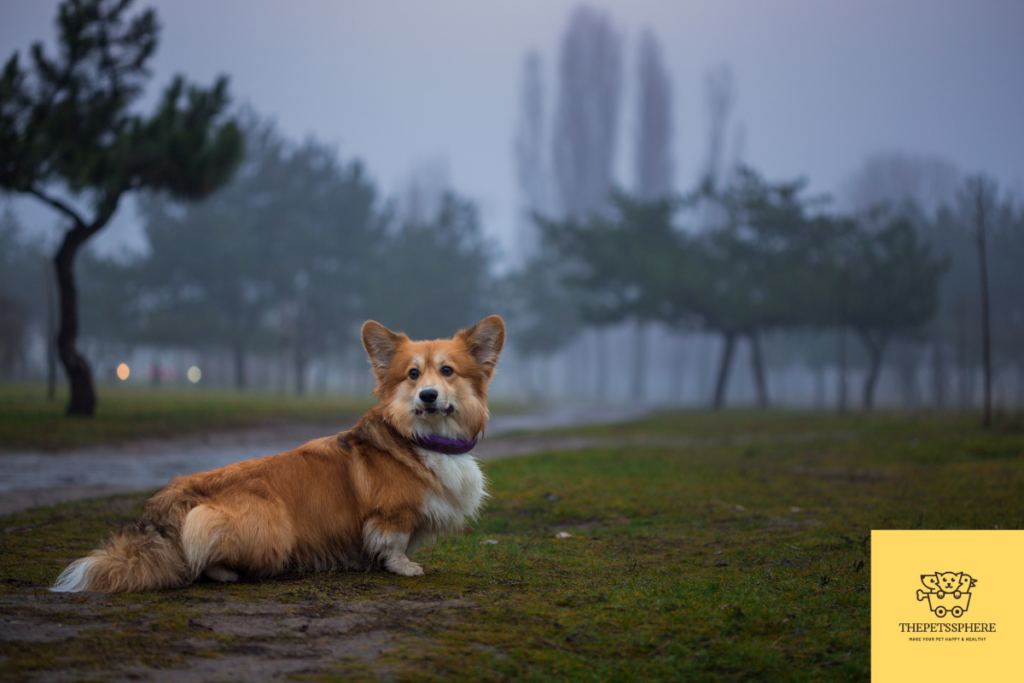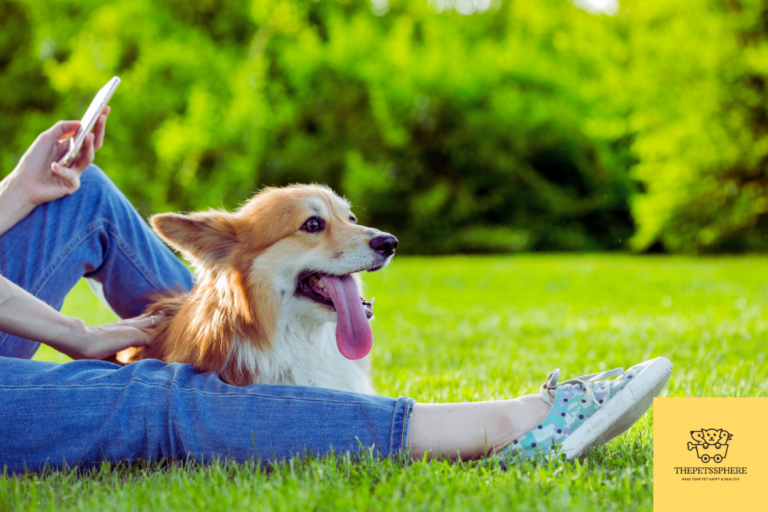A fluffy corgi is a corgi just like a cardigan or pembroke which has a long haired fluffy coat. They are typically smaller than the average size for both breeds, but they still retain many of their standard characteristics such as herding behavior and intelligence. Although there is no set height or weight range, most fluffies weigh in at 15 pounds or less.
They are considered ” Fluffy” because of the natural fur that they have which is usually long, soft and thick. Corgis are one of the smallest breeds of dog in the world and they are a herding descendant from Wales. They are one of the cutest breeds with their short stature and stubby legs! These fluffy little creatures are often highly energetic and always love to play around with you!
Now we will talk about the Origin and amazing history of Fluffy Corgis and some frequently asked questions related to this.

About Fluffy Corgi
A corgi is a type of small dog that comes in two breeds, the Pembroke Welsh Corgi and the Cardigan Welsh Corgi. The name “corgi” comes from an old English word meaning “to elbow”. They are known for being very energetic, playful dogs that love to take walks with their owners. This blog post will explore where corgis come from, what they are bred for and how they have evolved over time.
All puppies start out as cute little balls of fur but not all puppies grow up to be fluffy corgis! What makes this breed so special? Let’s talk about fluffy corgis and how fluffy corgis became fluffy!
Corgi History actually begins in Wales.
The first fluffy corgi is said to be descended from a group of dogs called Barbet that are believed to have accompanied the Celts, who were Celtic people that lived throughout Europe. The word “corgi” refers to any of three breeds of dog that are based on the Cardigan Welsh Corgi, Pembroke Welsh Corgi or the German Pinscher (although the modern dachshund is not directly related). In 1934 at a dog show in England, for the very first time longhaired Corgis were exhibited. The standard calls for medium-long hair with featherings on ears and legs. When the fluffy corgi of today was originally created there were two fluffy dog breeds developed, a Cardigan Welsh Corgi and a Pembroke Welsh Corgi. These two fluffy dog breeds probably share an ancestor in common who has been lost to history.
Corgis were bred for herding sheep, but they have proven themselves useful in many different fields over the years. They are high-energy, intelligent dogs that love to work and play hard! In 1930 they became one of the most popular pets across England and America as well as Ireland, Australia and New Zealand because of their adorable fluffy physique. The Queen mother even owned three fluffy corgis at once during this time period between 1939-1965.
Today fluffy corgis are still bred for herding, but also as pets, and some fluffy corgi puppies even find themselves in the show business!
What do Fluffy Corgis look like?
Corgi puppies grow the fluffy coat as they get older which is why in their baby stage they don’t have fluffy fur. Corgis are born looking like a red ball of fluff but soon enough, fluffy fur will come in. Corgi puppies are also born without the fluffy tail and pointy ears that they have when fully grown. The coat of the corgi puppy will be totally different from an adult dog, as it is usually shorter and comes in a variety of colors such as black and tan, red or tri-colored.
Will My Corgi Get Fluffier?
Yes, your Corgi will likely start to get fluffier around 4-to-6 weeks of age. Before that time it may not be known if they will have a fluffy coat or one more closely resembling the Pembroke Welsh corgi who only has long enough hair on the legs with short hair on face and other areas.
Generally, short haired dogs like Pembrokes fit under Corgi in the show ring guidelines as “textured” rather than “smooth.” Textured typically refers to an adult with shorter, firmer (less wavy) textures that straightens out after a while without showing any curl of wave within their coat. This includes hairy facial features such as eyebrows and eye fringe but also includes slightly fluffy coats on the outside.
Reason behind why some Corgi Puppies are Fluffy
Corgis are one of the most popular dog breeds in America, but not all corgis have a similar appearance. Some corgis are fluffy and cute while others may be short-haired or long-haired. The question is: why? Studies show that there are genetic factors that can determine whether a puppy will be fluffy or not, such as fur length, weight and shape of body. In addition to genetics, environmental factors also play a role in how much fluffiness an individual pup will have; for example, if they live in climates with more harsh weather conditions then their coat’s thickness would need to increase for insulation purposes.

Do Fluffy Corgis Shed More?
Fluffy corgi pups are fluffy because they have fluffy hair rather than fluffy fur. The pile (fluffy) part of the hair is what we refer to as fluffiness, but it’s not yet possible to determine whether fluffy dogs will shed more. Shedding can vary between individuals and their texture and thickness of fur; however, fluffy corgis shed their fluffy hair more often than dogs with short-hair. Fluffiness (of a fluffy dog) will be lost as they mature into adulthood, and they will gradually turn from fluffy to smooth.
The fluffy appearance of the corgi hides its thick undercoat that is used to keep up its body temperature in cold weather conditions. The corgi uses the long fluffy hair on top to protect them from rain or snow, but underneath they have long and dense fur coats which keeps them warm, especially during ice storms or extreme temperatures. The fluffy part of the coat is also resistant to dirt and mud due to its special texture. Sometimes when a puppy is fluffy as a puppy, it will eventually lose the fluffy look while growing into the adult stages. Fluffiness can disappear due to your dog’s health condition and their heredity. For example, if you have a fluffy Corgi dog but later on it grows out smooth fur this is because of its genetic makeup.
Fluffy corgi pups need regular grooming to prevent mats and tangles from forming in their coat. Once they reach adulthood fluffy corgis shed less than short-haired corgis; however, during springtime when there are temperature changes, fluffy corgis may experience shedding problems (due to both climate change and seasonal shedding). To help fluffy dogs cope with these shedding issues try doing light brushings every month. Going over fluffy Corgi pups with a pin brush or a slicker brush can both help remove dead hair and distribute the natural oils that are found in their fluffy hair to improve its condition. Make sure you select the right brush for your fluffy corgi depending on its length of fluffy fur, as long-haired fluffy dogs may need grooming tools such as combs, which could break off their fluffy hair rather than brushing it out. It is not suggested that you bathe fluffy corgis too often because this will increase shedding problems; however, if your dog gets dirty especially during winter when they get wet try giving them a bath but make sure the water isn’t cold because this will dry out their coat and leave it looking flat.
Are Fluffy Corgis More Expensive?
Corgis usually sell for $800-1,200.
Now the question is why fluffy corgis are more expensive than normal corgis? The reason behind this is very simple. If you want a fluffy pup, you should expect to pay more for the privilege of owning these unique and rare dogs.
But it doesn’t make sense for just fluffiness,you have to pay extra where fluffiness is considered as some kind of genetic defect in the Corgi Breed.
If the both Corgi parents have passed a hip and eye test, then there is no added cost. It is true that having parents with tested hips and eyes can minimize the risk of future health problems for our dogs. If both parents have been properly checked, then the chance of your new puppy developing hip dysplasia or progressive retinal atrophy (PRA) becomes very low as you’ve removed the genetic risk in half; making a loved fluffy corgi more cost-effective!
Moreover, by purchasing from a reputable breeder, they will also help owners with recommendations for training or veterinary care. On top of that, by purchasing through them rather than other sources like puppy mills or backyard breeders, potential buyers are able to get information about the lineage and personality traits of their furry friend. For example, a reputable breeder can talk you through how your pet may respond to certain situations or teaching tricks for your pet to learn.
One last thing regarding price ,like anything else in our world, cost depends on supply and demand. If we all wanted corgis at once and there were only a few of them left on earth, then they would be very pricey indeed.
Shetland Sheepdog vs Cardigan Welsh Corgi
The Shetland Sheepdog (aka the “Sheltie”) is a smaller fluffy dog that resembles a shaggy sheep and was once considered a distant relative of the corgi. However, DNA analysis has proven them unrelated to each other. Despite this they are sometimes crossed with corgis in order to produce fluffy puppies that have shorter hair than most traditional long-haired dogs. Over time English breeders began developing a separate short-haired fluffy dog that they called the Welsh Corgi. This fluffy corgi breed was originally bred for herding sheep, but proved to be a popular fluffy pet because of their cute fluffy appearance and furry fur!
Corgis in the Military
During World War I, some fluffy corgis were trained by the British military to carry messages between troops on the front lines and soldiers stationed back at headquarters. They also served as guard dogs, rescue dogs, couriers, and search-and-rescue dogs. It is said that three fluffy corgis even played important roles during battle in both WWI and WWII by helping soldiers find enemies hidden among them by alerting them with barking when there was danger.
In addition to military service fluffy corgis have served their fluffy country by being fluffy fire dogs, fluffy police dogs, fluffy herding dogs and more. Today there are many fluffy corgi organizations that promote fluffy activities like fluffy dog shows and fluffy agility competitions!

